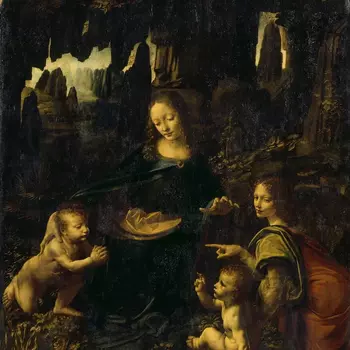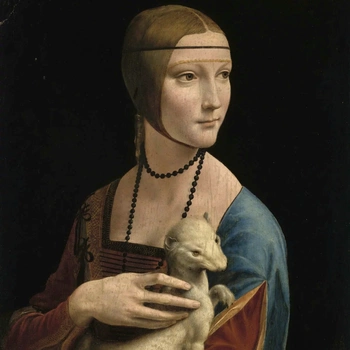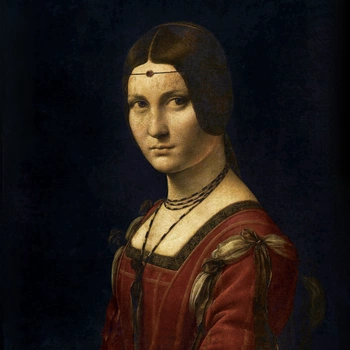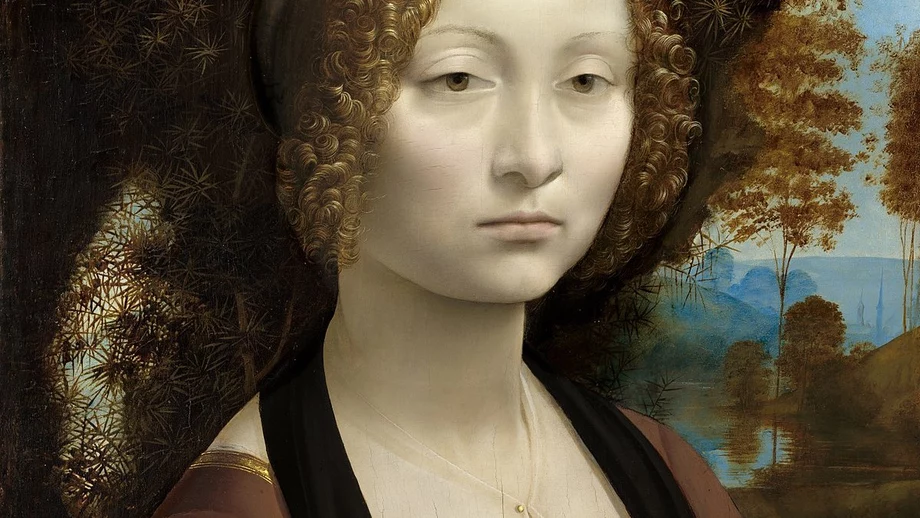
Ginevra de' Benci
The Portrait of Ginevra de' Benci is a Renaissance painting attributed to Leonardo da Vinci. It is dated between 1474 and 1478. It depicts the Florentine banker's daughter Ginevra de' Benci in front of a juniper tree in a landscape with a settlement. The painting is in the National Gallery of Art in Washington, D.C.
VIRTUTEM FORMA DECORAT
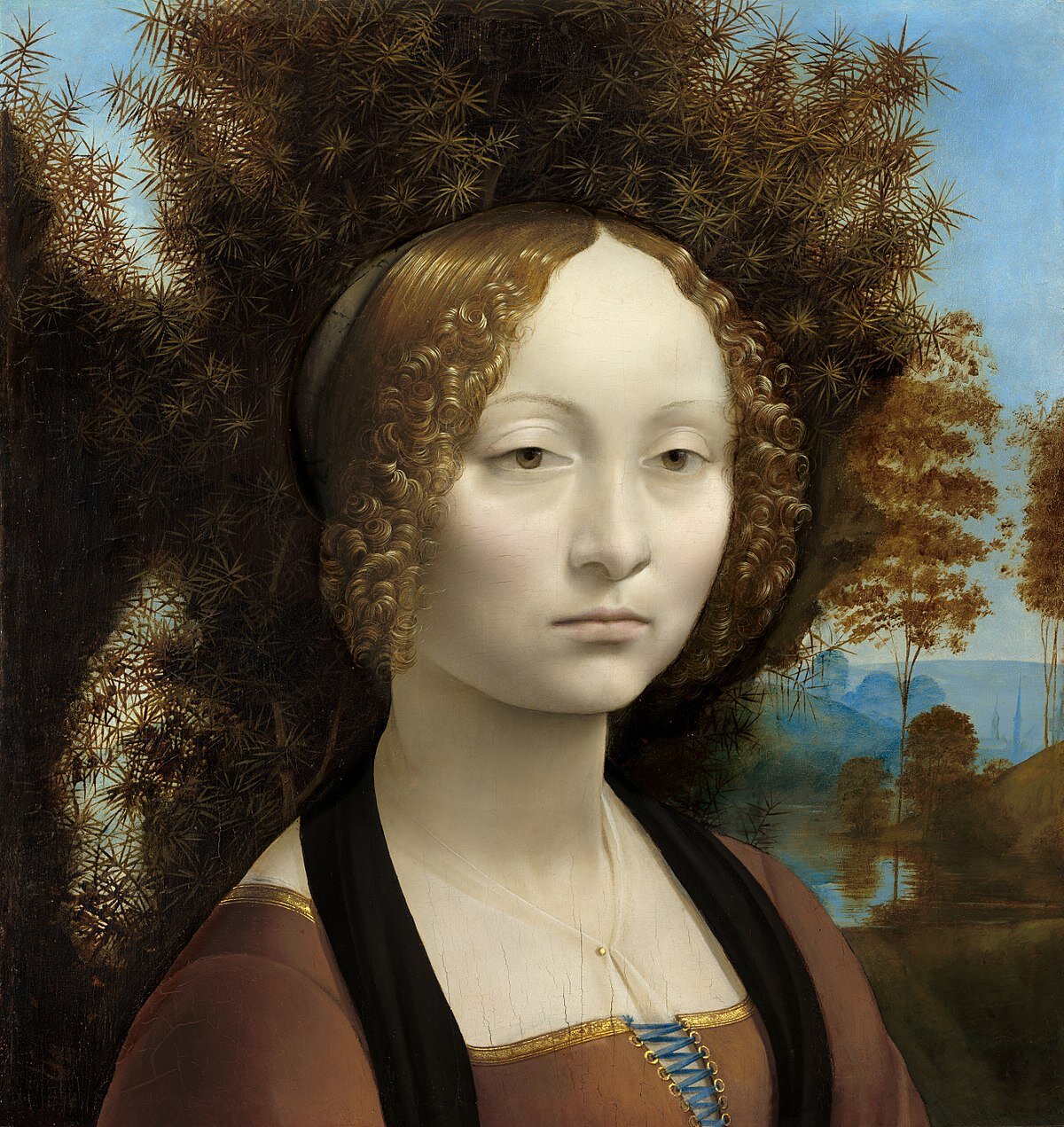
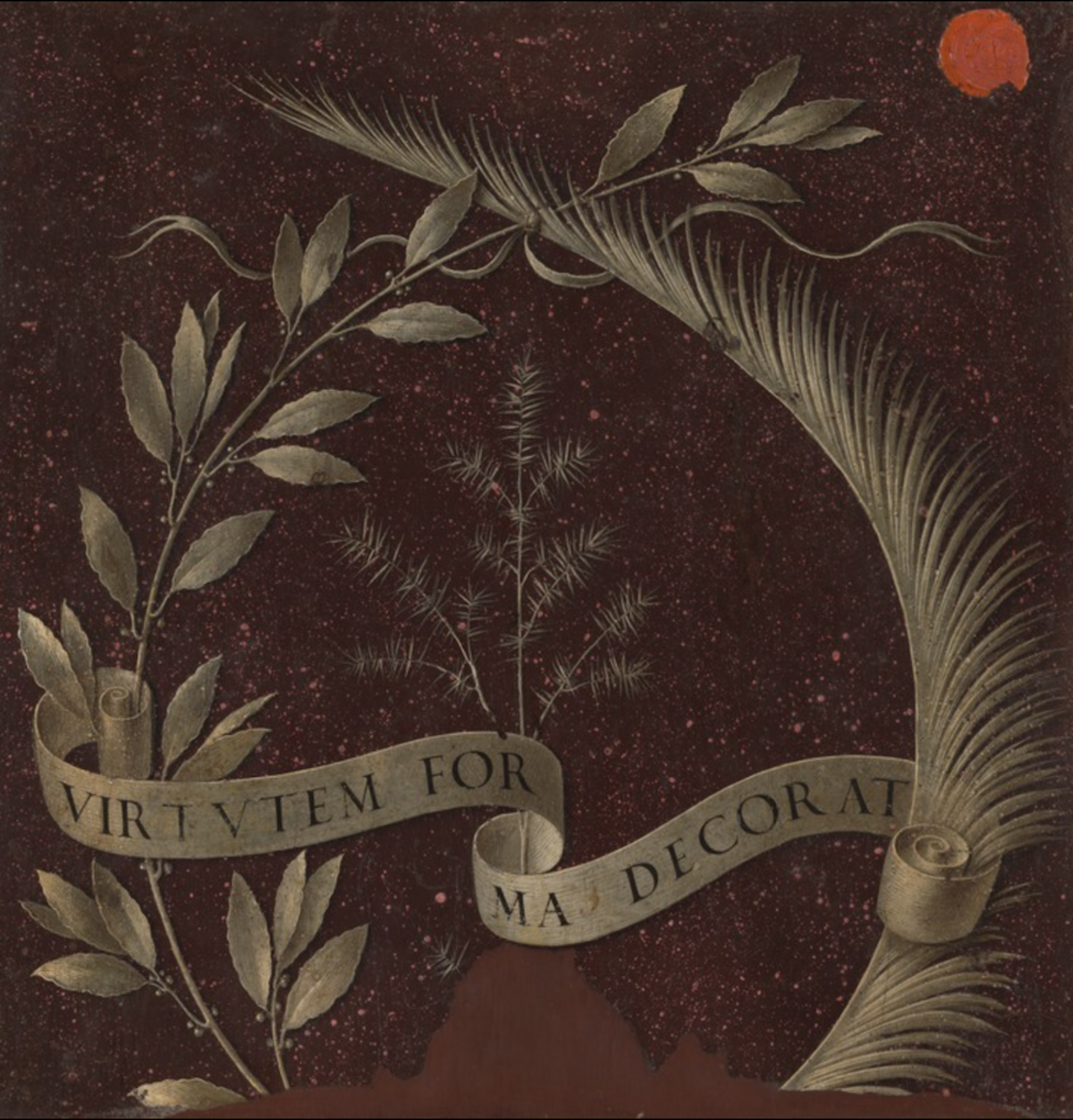
Whoever examines the painting without knowledge of geometry must consider it a work of Leonardo. The arguments are then too valid.
Ginevra de' Benci
Attributed to Leonardo da Vinci
1474-1478
Oil on wood
W:37,1 x H:42,7cm x D:1,1cm
- in height only 38,0cm visible, a lower part is hidden by the framing
National Gallery of Art, Washington D.C., USA
Who was Ginevra de' Benci?
The sitter is said to be Ginevra de' Benci.
Rich born
Ginevra de' Benci was born in Florence in 1457. Nothing is known about her mother. She probably died in childbirth.
On her father's side, Ginevra was the granddaughter of the heavily wealthy Florentine banker Giovanni di Amerigo di Simone de' Benci (1394-1455). He had worked his way up within the Medici Florentine business empire from simple accountant to partner of the company patriarch Cosimo de 'Medici. At his death, Giovanni de' Benci left his son Amerigo the second largest fortune in Florence, just after that of the Medicis.
Ginevra's father Amerigo Benci (1431-1474) initially followed in his father's footsteps and headed the Medici bank in Geneva from 1455 to about 1463. It was during this period that Ginevra was born. The Italian name of Geneva is Ginevra.
Amerigo Benci soon abandoned the banking business and moved back to Florence, where he accepted a position as prior and has since been active as a patron of the arts.
The family of her husband
Ginevra's father died in 1474 at the age of only 43. Shortly thereafter, the sixteen-year-old Ginevra became engaged to the 34-year-old merchant and widower Luigi di Bernado di Lapo Niccolini (b. 1440).
The Niccolinis were an old-established Florentine merchant family that was mainly active in the fabric trade (silk trade). They were also politically active. Many members of the influential Florentine city government came from the family. They were considered followers of the Medici.
Beautiful, clever and revered
Ginevra de' Benci was on the one hand known for her poetry, and on the other hand, because of her beauty, she herself was the subject of poems and had many admirers. The legendary Florentine statesman Lorenzo de' Medici (The Magnificent) and his entourage (Cristoforo Landino, Alessandro Braccesi) dedicated some sonnets to her.
The devotion of Bernardo Bembo
The Venetian diplomat Bernardo Bembo, who was very famous at the time, was also one of her admirers. He was active in the Republic of Florence from January 1475. Bernardo was in his early forties at the time, married, had a son and a mistress.
When he met Ginevra, he became her platonic admirer. They wrote each other letters and exchanged thoughts and poems. Although there were rumors of a love affair, Ginevra's virtue was always extolled. Bernardo left Florence after a year and a half in April 1476 and returned again in July 1478 for two years, leaving the city for good in May 1480.
The ostensibly platonic relationship between the two was probably the cause of gossip, according to a contemporary poem by Florentine Cristoforo Landino.
Ginevra's retreat
In a tax return from 1480, Ginevra's husband speaks of the high costs caused by a prolonged illness of his wife. Given the chronological context, it is possible that her illness was related to the departure of Bernardo Bembo. She is said to have retired to the countryside after overcoming her illness. Lorenzo de Medici later dedicated two sonnets to her, in which he consoles her and asks her not to look back.
After 1480, no sources are known to mention Ginevra de' Benci as an active member of Florentine society.
Death and descendants
Ginevra de' Benci died in 1520 at the age of 63. Her husband Luigi di Bernado di Lapo Niccolini died already in 1505 and their marriage remained childless.
Time of origin and owner
The debate about the authenticity of the work
The attribution of the painting to Leonardo da Vinci is considered controversial. The argument is mainly based on stylistic features. Thus, the sfumato typical of Leonardo is missing, and the figure also lacks any expression of liveliness.
Proponents of Leonardo's authorship argue that Leonardo was still very young when he created the painting. Leonardo was around 22 years old at the time. He is said to have painted the work under the influence of the Dutch masters, some of whose portraits were known in the workshop of his teacher Verrocchio. This is supposed to explain, for example, the paleness of the skin, which is so untypical for Leonardo.
Some other features also immediately give the impression that it is a work by Leonardo. The swirling depiction of the curls is Leonardesque. The thematic focus on landscape and nature is equally typical of Leonardo. He discovered aerial perspective, that is, that the landscape becomes bluer and bluer toward the horizon. This can also be seen. Overall, the painting gives the strong impression that it is a work of Leonardo da Vinci.
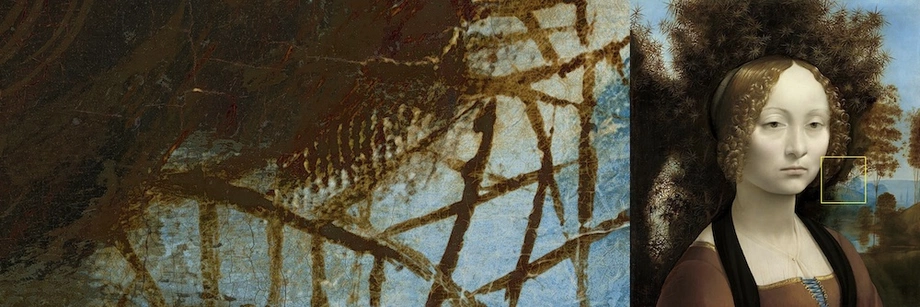
The bust of Dama col Mazzolino
The painting is said to have been created in Florence between 1474-1478. At this time, the 22-26 year old Leonardo da Vinci was already a full member of the Florence painters' guild and could have already worked as an independent painter. However, he decided to remain in the service of his teacher Verrocchio until about 1478. The reasons for this are unknown. Probably Leonardo shied away from the step because of the high number of competitors.
Andrea del Verrocchio produced a bust of a Florentine lady called the Dama col Mazzolino (Lady with a Bouquet of Flowers) around 1475. It is strikingly similar to the portrait of Ginevra de' Benci in hairstyle and clothing.
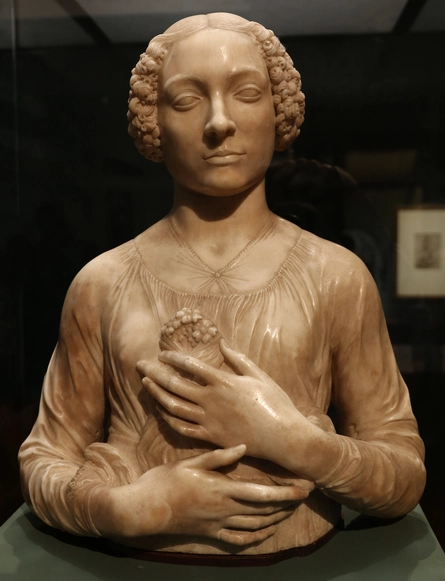
@photographedby Sailko, 2019, creativecommons.org/licenses/by-sa/3.0/deed.en).
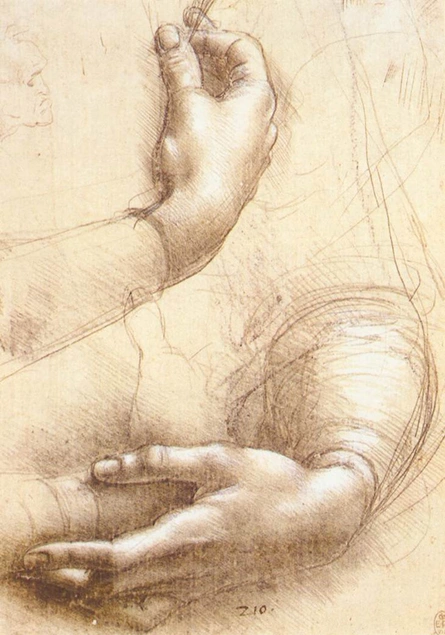
The competition of artists
Some authors assume that Leonardo's portrait of Ginevra de' Benci was a competition with his teacher Verrocchio. Accordingly, he wanted to show him with the portrait that painting is far superior to sculpture in its expressive possibilities. This contest over the ranking of the arts, known as the Paragone, was a centuries-old theme that Leonardo da Vinci grappled with throughout his life. His dispute with Michelangelo on this issue became particularly famous.
The author of the painting
There are two theories about the occasion of the painting.
Ginevra's future husband
For a long time it was considered likely that the painting was commissioned on the occasion of Ginevra de' Benci's engagement to Luigi Niccolini by their families. Then it would have been created around 1474. However, it cannot have been a wedding picture, since Luigi Niccolini was not depicted, and there is no painting of him that matches Ginevra's portrait.
Ginevra's admirer Bernardo Bembo
According to a second theory, the portrait was commissioned by Bernardo Bembo. He stayed in Florence from 1475-1476 and returned again for two years in 1478-1480. This is the reason why some authors date the painting to 1478.
That the painting is associated with Bernado Bembo is suggested by the painting on the reverse. The framed juniper branch, Italian Ginepro, can be interpreted as a pun on Ginevra. In addition, the rest of the symbolism refers to Bernado Bembo. He used this very representation of laurel branch and palm leaf for his personal seal. It is known from two of his personal books.
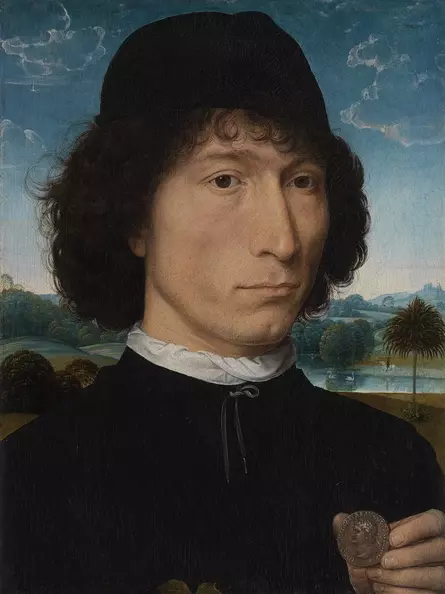
The painting shows Bernardo when he was at the court of the Duke of Burgundy. Shortly after he was sent to Florence

The laurel and palm branch are nearly identical to the representation on the reverse of the portrait of Ginevra. Between them the personal motto of Bernardo, Virtus et Honor (Virtue and Honor).
Virtus et Honor
Infrared examination revealed that the motto on the reverse was originally VIRTU(E?) and HONOR (engl. Virtue and Honor), but was later painted over. VIRTUS ET HONOR was the personal motto of Bernardo Bembo.

It is clearly visible that the two original words "VIRTUE" and "HONOR" have been painted over with "VIRTUTEM FOR MA DECORAT"
@Screenshot from the documentary Ginevras Story, 1999
Unknown whereabouts until 1733
The trace of the painting is already lost to its creation. There are no documents about the commissioning of the painting. The painting is not mentioned in contemporary sources in any other way. This is astonishing for the brilliant work of the young Leonardo, because it is stylistically far ahead of its time. It is surprising that such a qualitatively outstanding portrait of the socially well-connected Ginevra received no attention.
The first mention of it comes only 20 years after Leonardo's death. In 1540, the anonymous text of the Codex Anonimo Magliabechiano states only succinctly: "In Florence he painted after nature the portrait of Ginevra d'Amerigo Benci, which was so well executed that it appeared not as a portrait but as Ginevra herself."
In 1550, the first Leonardo biographer Vasari referred to the Anonimo Magliabechiano and also wrote very briefly, "Leonardo portrayed Ginevra d'Amerigo Benci, a very beautiful work". Until 1733, these are the only two sources that testify to the existence of the painting.
In the possession of the Princely House of Liechtenstein
The striking red seal in the upper right corner on the back of the portrait bears the coat of arms of the House of Liechtenstein. Around it the inscription "LIECHTENSTEIN 18 CH. GUARDIANSHIP SIG II. 1733 HOC[illegible]".
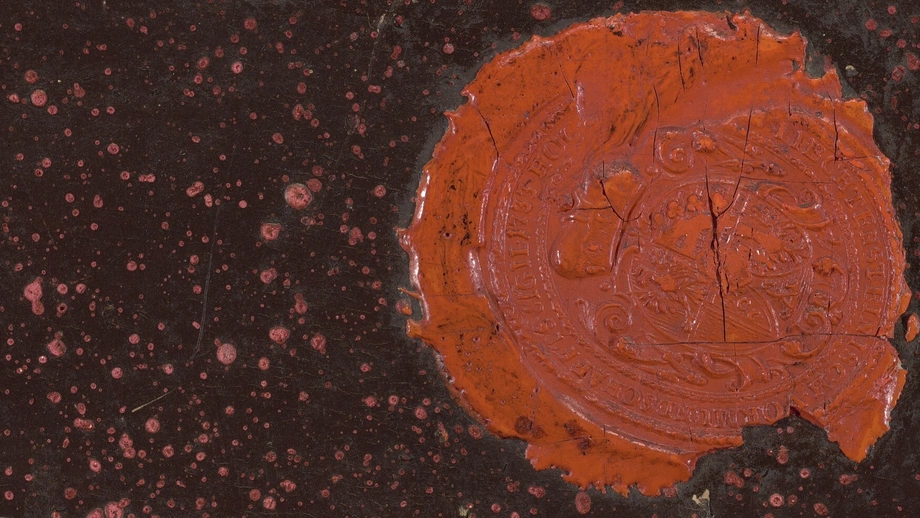
The meaning of the red seal
The red seal is special because it says something about the ownership before 1733. This seal was used only for paintings that belonged to the gallery of Prince Johann Adam (1657-1712). Johann Adam died in 1712, so the painting must have been acquired before that.
However, Prince Johann Adam collected mainly the magnificent paintings of the Italian Baroque. Thus, it is more likely that his father Prince Charles Eusebius (1611-1684) already acquired the portrait, as he preferred smaller paintings. Both princes traveled frequently to Florence and may have acquired the portrait there from private hands.
Finally, the red seal was applied in 1733 during the reign of Prince Josef Wenzel, who exercised guardianship over the minor Johann Nepomuk Karl from 1732-1745. The inscription on the seal refers to this.
First proof of ownership
Even though the work can be dated by the seal to before 1733, the first written mention of it does not occur until 1780, when it is mentioned in the official catalog of the Liechtenstein Collection, but attributed to the workshop of Lucas Cranach († 1553). At that time it was located at Feldsberg Castle (today Valtice/Czech Republic), which was the headquarters of the Princely House of Liechtenstein until 1945.
Public exhibition in Vienna
From 1805, the portrait of Ginevra de' Benci was publicly exhibited together with other paintings from the Liechtenstein Collection in the Garden Palace in Vienna. In 1944, shortly before the end of the Second World War, the portrait was moved to Vaduz Castle with the rest of the Vienna collection. Vaduz is the capital of the Principality of Liechtenstein.
Acquisition by the National Gallery of Art
In 1967, Prince Franz Josef II sold the painting for $5 million to the National Gallery of Art in Washington, D.C. This made the Portrait of Ginevra the most expensive painting sold in the world to that time.
The investigation by Mario Modestini
There were already doubts about the authenticity of the painting at that time. In 1966, the National Gallery of Art commissioned the world-renowned conservator Mario Modestini to examine the painting in Vaduz for an authorship by Leonardo. After days of examination, he had no doubts about its authenticity. According to his own statement, he compared the work using photographs of other Leonardo works that he had brought with him:
"I spent a lot of time examining the condition of the painting [...] By the end of the examination, I was convinced that the painting was 100% his [...] One of the things that convinced me that the attribution was correct was this hair. They are designed exactly the way Leonardo designed the waterfalls. In the same way. So typical of him. That was really the last point. I saw it and said, "There's no doubt about it. This was done by the same man who did these drawings" (Ginevra's Story, 1999 documentary).

The depiction of the curls finally convinced the art expert of the National Gallery of Art, Mario Modestini, of the authenticity of the portrait
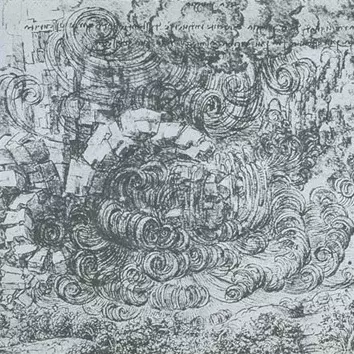
Leonardo had a very unique style of depicting swirling water
The patron
The purchase was financed by the Ailsa Mellon Bruce Fund. Ailsa Mellon Bruce was an American art collector and patron. As the daughter of the wealthy founder of the Bank of New York Mellon, Andrew W. Mellon, she had sufficient means to endow the National Gallery of Art with numerous art treasures.
Permanent exhibition
On Feb. 8, 1967, the painting arrived in Washington, D.C., and has been on display there ever since. In 1991, the painting was cleaned, restored, and received new framing.
Today, the portrait of Ginevra de' Benci can be seen in Gallery 6 in the West Building of the National Gallery of Art. It is the only Leonardo painting located outside Europe.
Symbolism
The meaning of juniper
The background of the portrait is dominated by an unnaturally dark painted juniper, which almost completely frames Ginevra. The juniper is an evergreen very adaptable and resistant coniferous tree, which occurs everywhere in the world. It bears once a year bluish shimmering edible fruits, the juniper berries.
Play on words with the name Ginevra
It is believed that the use of juniper alludes to Ginevra's first name. Juniper is called Ginepro in Italian. Therefore, juniper is understood to symbolize Ginevra.
Religious significance
Due to its evergreen characteristics, juniper is considered worldwide as a symbol of the multi-faceted life of nature: the blossoming of beauty, love and offspring, aging and finally death. Each culture places its emphasis on this. Some emphasize the evergreen qualities and life, while others emphasize the winter death that the evergreen juniper sees passing by.
The juniper in the painting reminds the viewer - Bernardo or her husband Luigi - of the facets of life as they contemplate Ginevra.
Geometric symmetry
When a juniper branch is viewed from above, it is noticeable that there are always three needles growing into an equilateral triangle. Every second shoot is rotated exactly 60°, forming a regular hexagon. In the understanding of the Renaissance, the juniper is a symbol of nature's tendency towards harmony and proportion.

The village in the landscape
In the background of the landscape three buildings can be made out. They are, from left to right, a mill, a church and a rock castle.
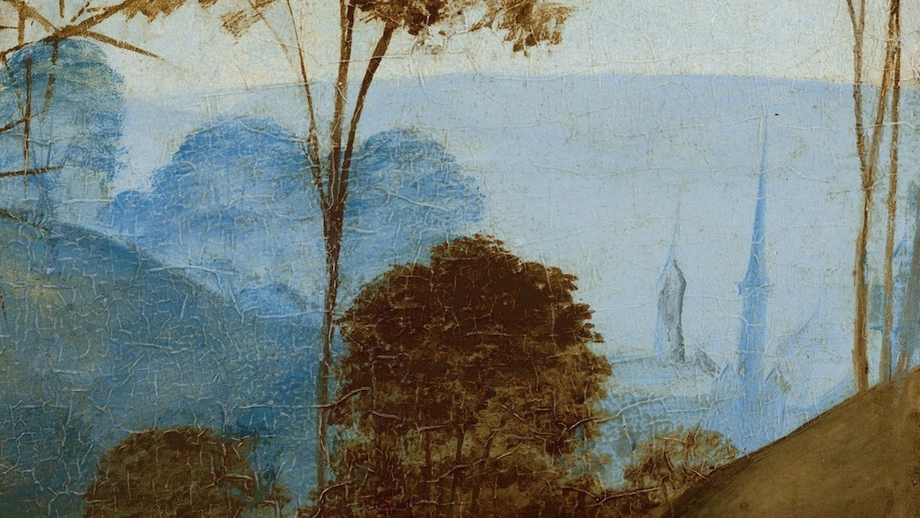
The buildings in the background of the picture have a political-symbolic meaning and symbolize the feudal system of estates in Europe. The model of the estates is also called the pyramid of estates:
- the first estate symbolized by the castle was the nobility
- the second estate symbolized by the church was the clergy
- the third estate symbolized by the mill was the peasants and later the merchant bourgeoisie.
The estates model was valid in Europe from the Middle Ages until the French Revolution in 1789. After that, it was gradually abolished in favor of a new democratic world order.
Laurel branch and palm leaf
The depiction of laurel branch and palm leaf on the back of the painting has great similarity with the personal seal of Bernardo Bembo (see the client of the painting). It shows a personal emblem (Italian imprese). It is supposed to show through symbolism the determining character traits of a person. An imprese is always connected with a mostly Latin motto. Due to the symbolism and language, its meaning can only be understood by the humanistically educated and thus represents a distinction from less educated classes.
What is the importance of the laurel?
The god Apollo fell madly in love with the nymph Daphne, who did not return his love. Fleeing from Apollo's pursuits, she begged her father, the river god Peneios, to transform her into something that would excite Apollo less than her graceful beauty. Thereupon she froze into a laurel bush. Since then, Apollo wore a laurel wreath as an attribute in memory of her. Apollo is the god of light and the arts.
In the context of the depicted Ginevra, the laurel alludes to her enjoyment of poetry.
In addition, the laurel wreath has a political character to this day. Especially ancient Greek and Roman rulers wore it as a symbol of victory and glory. A laurel wreath was also put on victorious Roman generals on the occasion of their triumphal procession in Rome. The ancient rulers were mainly concerned with equating themselves or others with Apollo, the light-bringing god.
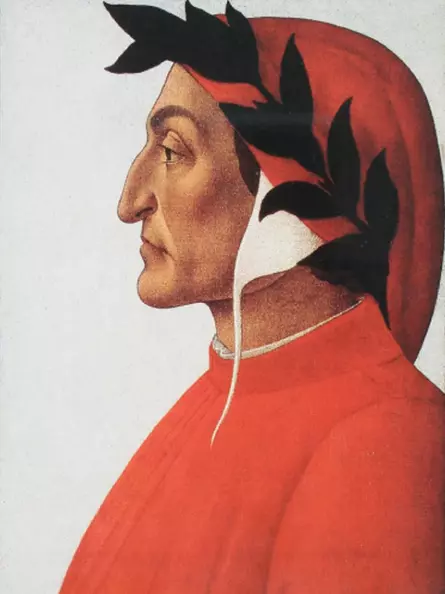
Dante wears a laurel wreath as a symbol of the god Apollo, who was also the god of arts
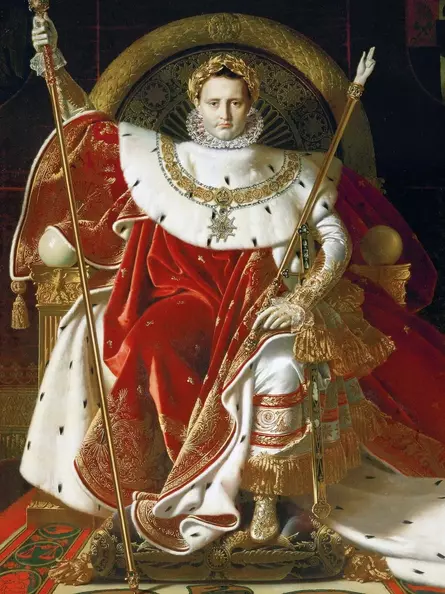
The French emperor wears a laurel wreath as a symbol of victory. For a long time after the French Revolution, Napoleon, a citizen, was regarded in Europe as the liberator of peoples from aristocratic rule. He also had Pope Pius VII arrested. The civil code introduced by Napoleon is valid in France slightly changed until today
What is the significance of the palm leaf?
The palm leaf has basically two symbolic uses, one cultural and one religious.
In many ancient cultures of the Orient, the palm leaf was considered a wedding symbol because of its symmetry. The paired arrangement of the leaves thus alludes to the upcoming marriage of Ginevra de' Benci. The palm leaf is shown viewed from the side, so that only one half is visible. The half palm leaf symbolizes one half of the betrothed couple, i.e. Ginevra.
In addition, the palm leaf is a religious symbol of peace mainly in Judaism and Christianity. The Jews celebrate the Feast of Tabernacles, originally a harvest festival, in memory of the Exodus from Egypt. Huts made of palm leaves are erected for the occasion.
In the Christian tradition, the palm leaves commemorate Jesus' entry into Jerusalem on Passover. The Jewish Passover, like the Feast of Tabernacles, is celebrated in memory of the Exodus from Egypt. The people laid palm fronds at Jesus' feet out of joy before the arrival of the Messiah. Palm Sunday still marks the beginning of Holy Week, which ends with the crucifixion and resurrection of Jesus.
In the Judeo-Christian tradition, the symbol of the palm tree is thus closely connected with the Exodus from Egypt and the Passion of Christ.
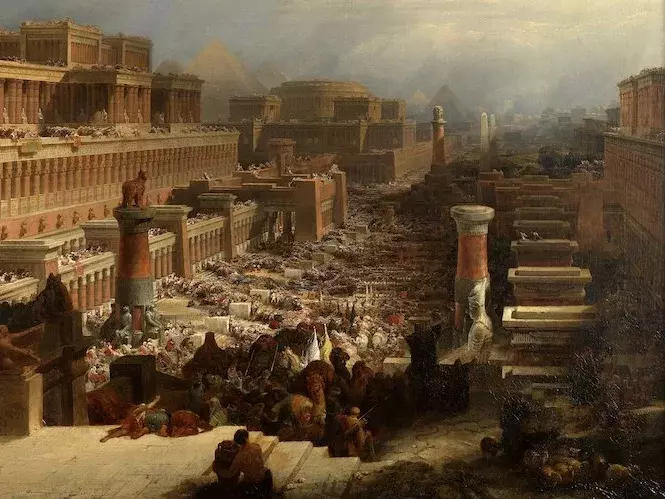
Moses leads the Israelite people out of Egypt after 400 years of slavery. The pyramids in the background
Combined image of laurel and palm tree
If laurel and palm are combined in equal rank, as on the reverse of the portrait, this has a political character. The laurel in its derived form stands for victory and glory, the palm complements the peace achieved through it. That the diplomat Bernardo Bembo, who was active throughout Europe, made this symbolism his seal is hardly surprising.
That his symbol frames the smaller (younger) juniper, which is supposed to symbolize Ginevra, is often interpreted as an allusion to an intimate relationship between the two.

The meaning of the inscription
All three branches are connected by a banner. The inscription on the banderole reads VIRTUTEM FORMA DECORAT (engl. Beauty adorns virtue) and refers to the ancient philosopher Plato's view that outer beauty is an expression of inner virtue. This view was further popularized at the time of the Renaissance by the extraordinarily popular poet Petrarch.
If Bernardo Bembo was indeed the patron of the painting, the banner would emphasize the moral, virtuous, and Platonic nature of his relationship with Ginevra. Because she is beautiful, according to Plato, she must also be virtuous, and this would preclude an affair with the ve married Bernardo Bembo.
The marble slab from porphyry
Porphyry, like juniper, is shown both on the front of the painting and on the back of the painting.
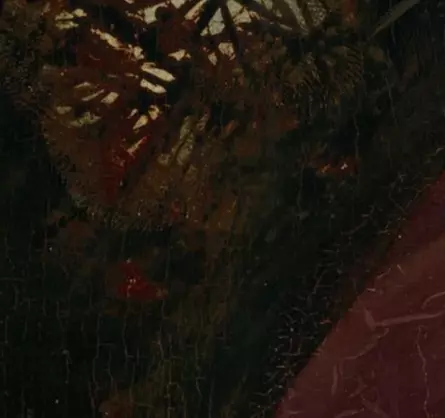
Distinctive red spots at the left edge of the image identify the dark background left of the juniper as porphyry rock
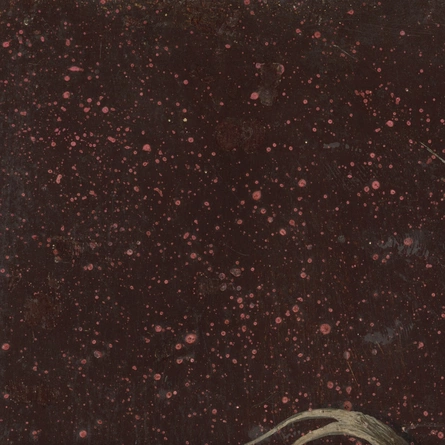
The branches and the banner were placed on a porphyry slab. The atypical for a porphyry slab round, unevenly distributed inclusions of the stone remind of a starry sky
Porphyry is a collective term for rock types of volcanic origin, which are characterized by a typical purple color with colored mineral inclusions. Although not a particularly valuable stone today, porphyry was a rare and expensive raw material until the late Middle Ages. In Roman antiquity, it was mined only in Egypt.
Due to the purple color of porphyry, the material was only allowed to be used for effigies of Roman emperors. Even in the Middle Ages, the emperors of the Holy Roman Empire were buried in porphyry coffins, as shown by the tomb of Emperor Frederick II († 1250) in Palermo Cathedral.
In Leonardo's environment, it was above all the Medici who had a preference for porphyry. The founder of the Medici's legendary wealth, Giovanni di Bicci de' Medici († 1429), had a slab placed on his marble coffin, adorned by a circular porphyry slab.
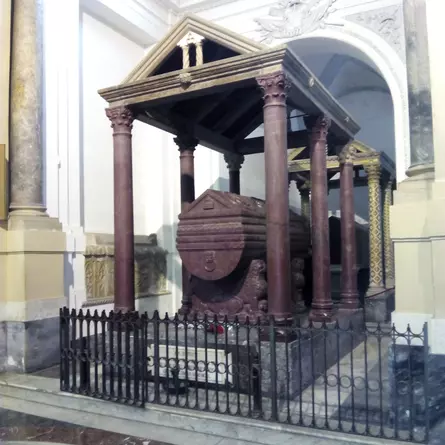
The coffin as well as large parts of the tomb are made of porphyry
@photographed by Lasterketak, 2015, creativecommons.org/licenses/by-sa/3.0/deed.de)
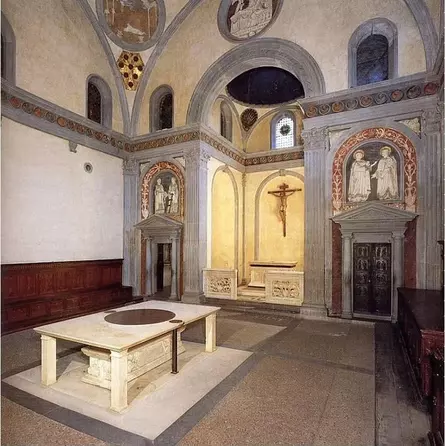
The circular slab above the coffin is also made of porphyry
Why is porphyry shown?
The porphyry used in the painting thus superficially assumes a representative task. It is supposed to demonstrate the self-confidence of the rich Florentine citizens, who thus refer to the tradition of purple colors as a symbol of imperial power and wealth, which goes back to antiquity. About 40 years after the assumed year of origin of this painting, a Medici was elected pope for the first time.
However, Ginevra de' Benci only partially satisfies this high princely claim. Her father was the manager of the Medici Bank in Geneva, her grandfather the right hand of the patriarch Cosimo di Medici, the wealth of the de' Benci was enormous, but compared to that of the Medici rather modest, their political power limited. The porphyry therefore seems exaggerated as a symbol of power and wealth.
Porphyry was not only used for tombs, representative statues of emperors made of the material have also been preserved. Nevertheless, the porphyry in the painting cannot be denied a certain death cult symbolism analogous to juniper. The fact that it is mainly depicted on the back of the painting makes one think of a tombstone there. The front side would then show the living Ginevra, the back side would refer to her transience and death.
Painting analysis
Representation errors and anomalies
Ginevra's right eye is noticeably larger than her left.
Her head is so spherical that it seems to be painted in a circle
The primary stylistic device of the painting is contrast.
- The red of the foreground is contrasted with the blue in the background
- The bright face of Ginevra is surrounded by the juniper, which is painted much too dark
- The plastic but stiff bust of Ginevra is contrasted with the soft forms of the landscape
- Almost straight lines on the dress and hair contrast with the circular hills of the landscape
Painting of the front and back are not self-sufficient, but connected by recurring elements
- The marbling of the stone plate on the back is repeated on the front in the rock at the lower left edge of the picture
- A branch of the juniper of the front side is in the center of the back side
- The almost triangular bust of Ginevra is repeated in the arrangement of the two large branches of laurel and palm, which also appear as a triangle.
I The face divided in two
The direction of Ginevra's gaze seems unclear. This is because the face has been painted from at least two perspectives, which have been brought together in such a way that they still look like a coherent whole.
This becomes all the clearer as soon as her right and left face halves are covered alternately (mouseover). The dividing line of the initially two views of the head can be determined relatively clearly. It forms a line along the middle parting and the golden button on Ginevra's cleavage (yellow dots and orange vertical line).
It can be clearly seen that Ginevra's left half of the face is looking frontally at the viewer. However, the right half of Ginevra's head is turned away from the viewer. Here, her right eye seems out of place, because it is painted frontally, contrary to the head position of her right side, and is also too large compared to her left eye. This becomes especially clear when, in addition to her left half of the body, her right eye is also covered (mouseover right side).
Rediscovery of the old principle in modern times
The idea to combine two faces into one, or to show a face in several perspectives next to each other so that they appear as one, is very unusual for the Renaissance, especially since in the portrait of Ginevra this was also technically executed in high quality. So well, in fact, that it is not initially noticeable.
The basic idea was elaborated in painting only in the 20th century. First of all by the cubists, known for it are especially the portraits of Pablo Picasso (*1881) and Georges Braque (*1882).
Salvador Dalí (*1904), however, demonstrates the principle more vividly. The famous surrealist painter shows in his complete works a constant engagement with the art of the Renaissance and with that of Leonardo da Vinci in particular. He repeatedly took up the idea of multiple perspective for optical illusion. The lower representations show amazing parallels to the portrait of Ginevra de' Benci (middle parting, side curls, chest covering and the focus on the landscape on the right).
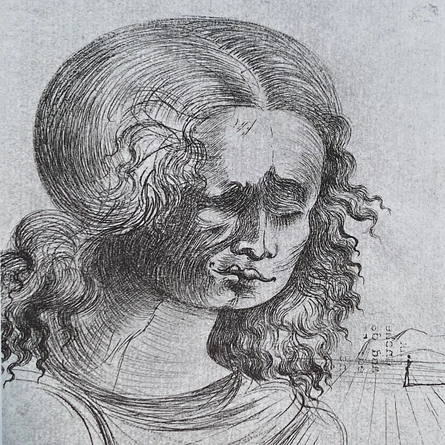
Dali was certainly inspired by the portrait of Ginevra de' Benci. The drawing illustrates very clearly the principle of multi-perspective faces, which was also applied to Ginevra de' Benci.
© Mrs. Edwin A. Bergman Collection, Chicago
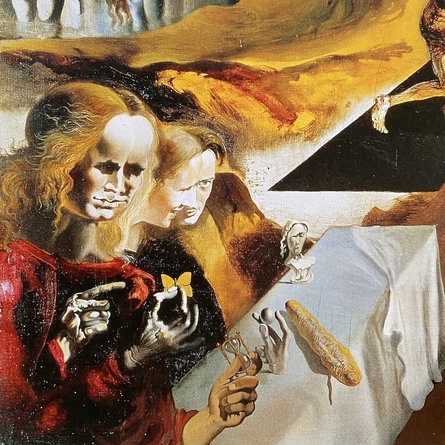
Particularly noteworthy is the merging of the faces of Dali's great love Gala and himself in the back of the pair. Dali, in contrast to the portrait of Ginevra de' Benci, shows only two views per head
©The Art Institute of Chicago. Joseph Winterbotham Collection
II The face divided into three parts
The division of the face into only a left and right half of the face seems insufficient. There must be three views, since Ginevra's right eye does not seem to fit either half. It is now to be investigated along which boundaries the three views of the head run. A vertical dividing line has already been found: Middle parting and golden button on the neckline.
Golden rectangle
A golden rectangle is a special rectangle where the sides are in relation to each other in the golden section.
- If the line between the center parting and the golden button is moved to the right edge of the image, a golden rectangle is created (orange-transparent rectangle)
- The height of the rectangle is exactly 2/3 of the height of the painting (the height of the painting refers to the visible part; a lower strip, about 5cm wide, was always hidden by framing)
Circle
The circular representation of Ginevra's head is striking.
- Her head can be exactly enclosed in a circle (yellow circle)
- The center of this circle is exactly in the pupil of Ginevra's right eye (yellow dot)
- The central perpendicular of the painting passes exactly through Ginevra's right eye (red vertical line).
- The circle around the head has the diameter of half the width of the painting.
- The circle has the same distance to the left and to the right, so it is horizontally exactly in the center of the picture.
Equilateral triangle
The portrait of Ginevra de' Benci is crossed by numerous lines and triangular shapes that are parallel and at a 60° angle. The 60° angle is the interior angle of an equilateral triangle. The bust of Ginevra therefore appears triangular overall.
Leonardo da Vinci used this shape in his central major work, The Last Supper. There, the Jesus Christ is painted in an equilateral triangle.
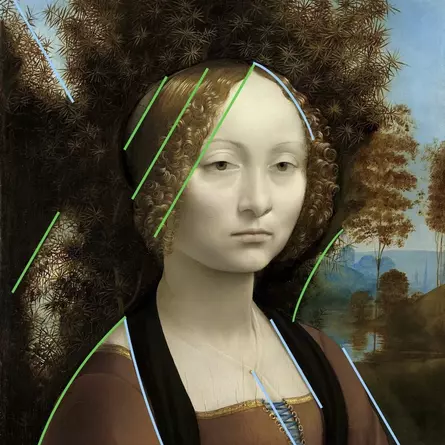
The painting is crossed by lines at an angle of 60°. Sometimes inclined to the right, sometimes to the left (green and blue lines). Striking triangular shapes appear on the head and shoulder. At the same time her right shoulder and right curls seem to be almost on one line
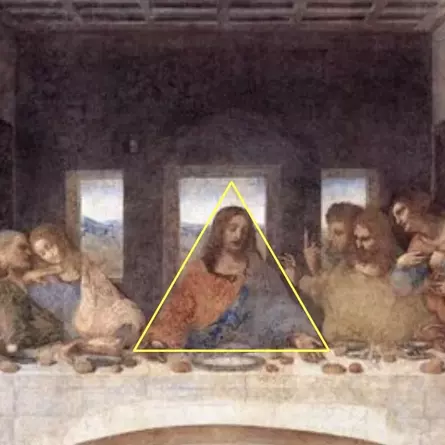
The hands and head of Jesus span an equilateral triangle
The equilateral triangle, in which the Ginevra was painted, is to be identified now. For the basic orientation serves an at first only imagined line from her middle parting to her shoulder (left white line). It will be shown by clear geometrical relations that exactly this equilateral triangle was in the intention of the painter.
- The upper left corner of the golden rectangle and the circle around Ginevra's head intersect exactly at one point
- From this point, a line can be drawn at an angle of 60° to the lower edge of the picture (white line on the left).
- This line is exactly as long as the picture is wide
- This line runs conspicuously exactly along Ginevra's right curls and is exactly tangent to the conspicuously round shoulder
The left side of an equilateral triangle is now clearly defined. By mirroring this side along the central perpendicular (red vertical), the equilateral triangle we are looking for is created.
- The length of the right side of the triangle (white line) and thus of all sides of the triangle is 14/16 of the width of the image. The division into 16ths will be decisive for the geometry of the picture, as will become clear
- From the two points where the circumcircle of the head (yellow circle) intersects the equilateral triangle, a 90° angle can be drawn to the pupil and thus the circumcircle
It is remarkably elegant how the different angles, proportions and shapes relate to each other. It is not possible to change even one detail without completely destroying the mutual relationships.
- The horizontal bisector (red horizontal line) divides the just created large equilateral triangle again into a smaller equilateral triangle terminating upwards. In its center is the right eye of Ginevra (yellow area).
The three faces of Ginevra
Circle, equilateral triangle and golden rectangle are typical shapes of classical geometry. The painter of the portrait of Ginvera de' Benci determined them to stencils in which he placed the three perspective views of Ginevra's head (II + mouseover).
- The part of the face in the equilateral triangle looks at the viewer frontally
- if the golden rectangle and the equilateral triangle are covered at the same time, an anonymous head looking to the side is visible
- the face in the golden rectangle looks frontally at the viewer analogously to the one in the equilateral triangle, but it is somewhat smaller and therefore further away. This is especially clear from the size of the eyes
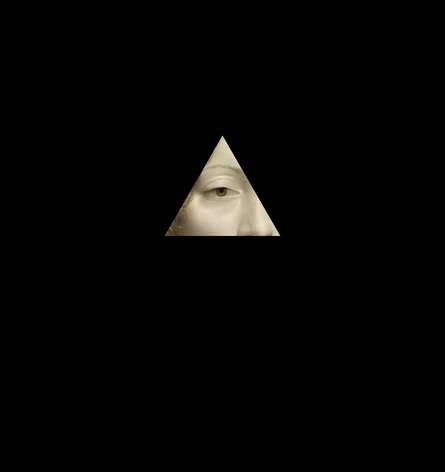
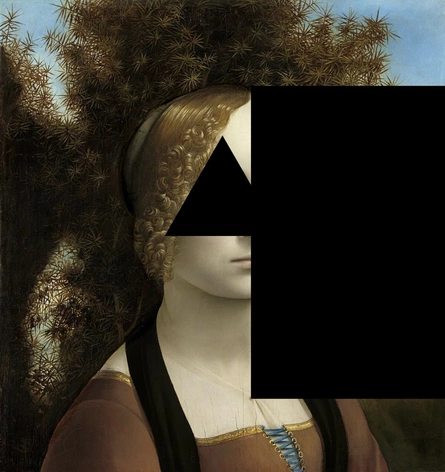
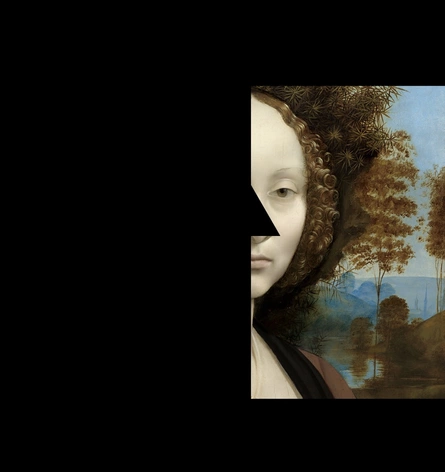
From this construction can be explained the different moods in the expression of Ginevra, which so fascinates many viewers. In reality, however, they see three different faces at the same time, in different sections and in different perspectives.
To determine the different perspectives exactly has been possible by means of geometry. The painter gave hints for this by marking points important for the geometry of the picture, e.g. by
- he painted a central parting, which represents the dividing line of two views of a face or
- he painted a golden button leading to a golden rectangle
- he placed the head of Ginevra in a circle, the center of which is her right eye
- he placed numerous characteristic lines in the painting at an angle of 60°, the interior angle of an equilateral triangle.
Placing three different facial views inside each other in such a way that they look like one face is reminiscent of certain medieval representations called tricephalus.
What is a tricephalus?
A tricephalus (three-face) is a symbolic representation of the Trinity of God (Trinity), little known today, which was used mainly in the Middle Ages.
This type of representation of the Trinity was banned by Pope Urban VIII during the Counter-Reformation in 1628. As a result, this symbol was removed everywhere in the Catholic sphere of influence. Here is a typical representation.
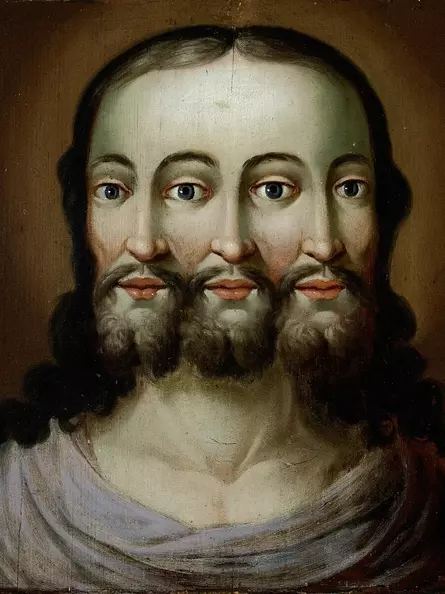
The three-faced representation of the Trinity was banned by the Pope in 1628
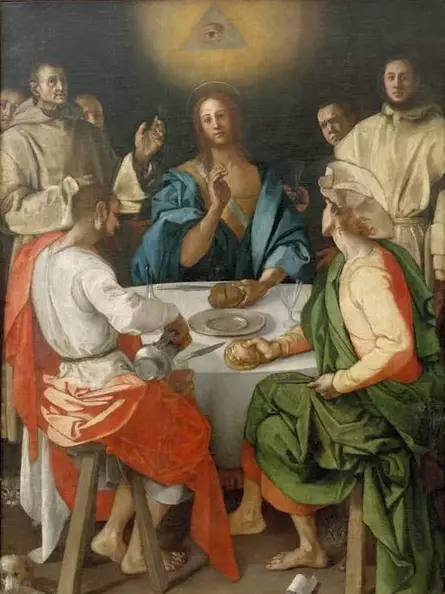
Pontormo was a pupil of Leonardo around 1508. The original tricephalus in this painting was painted over with the new symbol of the Trinity, the eye of God (upper edge of the picture), after the papal ban of 1628.
What is the eye of God?
When the tricephalus was banned by papal decree in 1628, the faithful needed a new symbol of the Trinity of God. As a successor to the tricephalus, the Eye of God evolved.
It shows a stylized eye in a triangle surrounded by a halo of rays. The triangle stands for the Trinity of God and is mostly equilateral, but is also often depicted as a right-angled triangle.
Leonardo's pupil Jacopo Pontormo
Jacopo Pontormo was a student of Leonardo around 1508. Pontormo's famous painting, "Supper at Emmaus," is often referred to as the oldest depiction of the all-seeing eye.
However, the exhibiting museum in Florence, the Uffizi, has discovered that the eye of God depicted is the result of a later overpainting. According to the museum, there was originally a tricephalus in its place. Exactly when the overpainting took place is not known. Overpaintings of private paintings need not have been carried out immediately with the papal ban of 1628. They could also take place decades later, for example on the occasion of a public sale.
The oldest representation of the eye of God
The symbol can be traced for the first time in 1682. It is depicted on an illustration found on a work edition of the writings of the German theologian Jakob Böhme.
Even if older symbolic representations of single eyes (Egypt), triangles (Israel) and halo (Christian Europe) can be found, the complete symbol of the eye of God in a triangle and with halo is absolutely new and not provable before 1682.
How did Leonardo know this symbolism?
The painter of the portrait of Ginevra de' Benci painted three views of Ginevra's face, reminiscent of a tricephalus. This type of representation was still widespread in the Renaissance, Leonardo certainly knew it.
Moreover, as it could be shown, the painter of the portrait has emphasized her right eye through numerous geometrical relations, and set it in an equilateral triangle to boot. This kind of representation reminds of an eye of God, only the halo is still missing.
If such a corona could be proven and thus the use of a symbol, which can be proven for the first time only in 1682, thus approx. 200 years after the assumed origin of the portrait, this would awaken serious doubts about the dating and thus the authorship of Leonardo. For then it would have to be clarified where Leonardo knew this symbol from, and why he showed it on a painting that also uses the symbolism of a tricephalus. Probably this would not succeed conclusively and a dating after 1682 would be compelling.
II Back side: A magic triangle
The emblem on the back of the portrait has also been constructed according to geometric rules. The basic triangular shape of the front is also found here. It results from the arrangement of the laurel and palm branches.
Visually, three points are particularly emphasized:
- The knot of the ribbon at the top, at the intersection of the laurel and palm branches.
- the center of the spiral at the left end of the ribbon
- the center of the spiral at the right end of the banner
- an ellipse in the center of the banner
The triangle of symbolic angles
These points are symbolically related to each other by the interior angles of the triangle made of them. The interior angles are 60° (red and blue line), 45° (green and blue) and 75° (upper angle). The symbolism refers to the simplest forms of classical geometry.
- 60° angle: the interior angles of an equilateral triangle
- 45° angle: the angles of the diagonals of an equilateral quadrilateral (square)
- 72° angle: the center angle of an equilateral pentagon (pentagon)
- + 3° = 75°: The 3 is the approximation number for the circle number Pi (~3.14) since ancient times.
Since the 75° angle results from the interior angle theorem as a remainder of 180° - 60° - 45° = 75°, but can be decomposed into 72° and 3, such a triangle gets a magic character. It symbolically unites all basic forms of classical geometry via the values of the angles: circle, equilateral triangle, square and regular pentagon. The construction of a regular pentagon is not trivial and requires knowledge of the golden section.
Golden Section
Consequently, there is also a golden section, the most famous proportion of classical geometry
- The extension of the central perpendicular (yellow) from the upper triangle point to the lower edge of the picture is divided by the blue line in the golden section.
The tilted circle
A circle is also shown.
- Where the band wraps around the juniper branch in the center, an ellipse (white area) is created in the middle. The ellipse is actually a circle that has been tilted exactly 45° backwards. However, due to the perspective distortion, the circle appears elliptical.
Spirals
The banner is wound several times. Spirals are formed at the beginning and the end. These are not randomly formed, but also refer to geometry
- the left spiral is a golden spiral, because it has the proportions of the golden section
- the right spiral is an Archimedean spiral, because the spiral arm always intersects the radius from the center of the spiral in the same distance
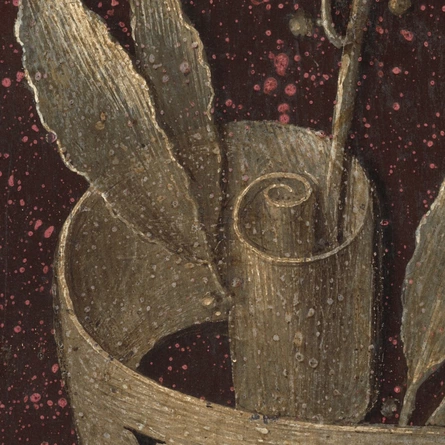
The left part of the band forms a golden spiral
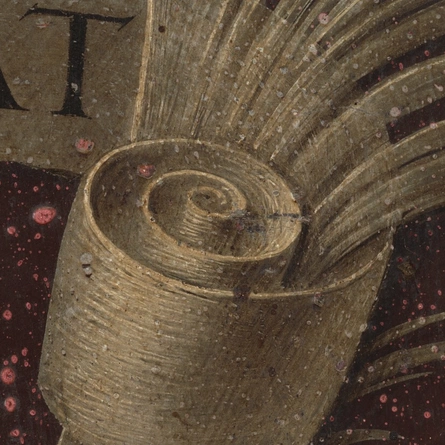
The right part of the band forms an Archimedean spiral
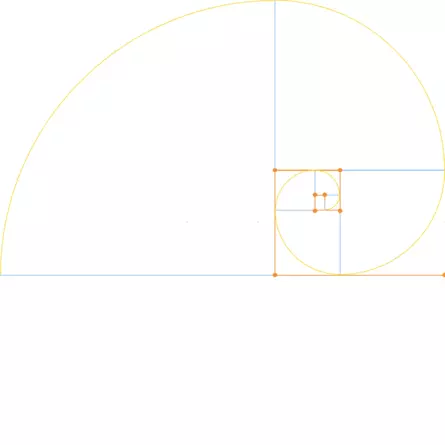
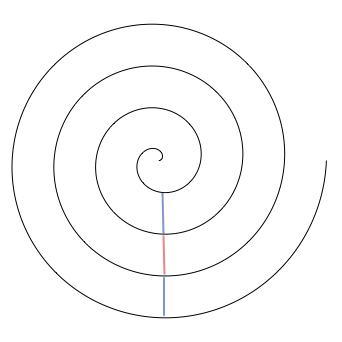
It is formed when the radius of a circle doubles every 360° while rotating around the center. The radius from the center of the spiral always intersects the spiral arm at the same distance (blue and red lines).
What does the symbolism refer to?
The numbers 3, 4, and 5, and from them the geometric shapes of the equilateral triangle, the square, and the regular pentagon, have been classical symbols of geometry since ancient mathematicians. And all these shapes have their origin in the circle. After the point and the line, it is the most original geometrical element. Geometry expresses that all being is based on simple harmonies and proportions, or the combination of them. This idea has been taken up here.
Overall, the geometric relationships of the reverse refer to the same symbolic angles and shapes found on the front. They underline the already established geometric relationships of the painting and thus seem like a reduced version of the symbolism used.
At this point, at the latest, it becomes clear that the painter was also concerned with geometric symbolism in addition to the classical emblematic symbolism (laurel, palm and juniper). It is astonishing that this has not been taken into account in previous studies of the painting.
III Kreuz und Davidstern
The shifted image center of the reverse side
Due to the general symmetry on the back, it could be assumed that the juniper is positioned in the center. However, this is not so. Therefore, it is argued that the painting was cropped on the left.
If this view is followed, a piece must be added to the back on the left (dark red stripe) so that the juniper is exactly in the center of the picture (light red line). This missing part would then also be visible on the front side.
Effect of the widening on the geometry of the front side
Surprisingly, the changed width of the image in this way leads to numerous other geometric relationships on the front side.
The width of the resulting stiffener is exactly 3.14% of the original image width (dark red stripe). This is the numerical value of the circle number Pi.
the tree at the right edge of the picture has strikingly exactly the same width of the applied stripe (red and red-transparent stripe)
The rectangle
- the formerly golden rectangle of center parting, golden button, and image border now has the exact aspect ratio of 2:3 (yellow rectangle)
This rectangle brings the portrait close to Leonardo da Vinci's two most famous paintings, the Mona Lisa and Leonardo's magnum opus, The Last Supper. In both paintings, the aspect ratio of 2:3 is prominently featured.
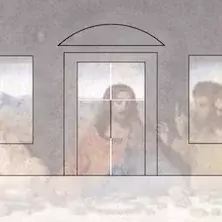
The dimensions of the door in the entrance area can be reconstructed in perspective. The interior frame of the door is laid out in the ratio of 2:3 (white and black lines)
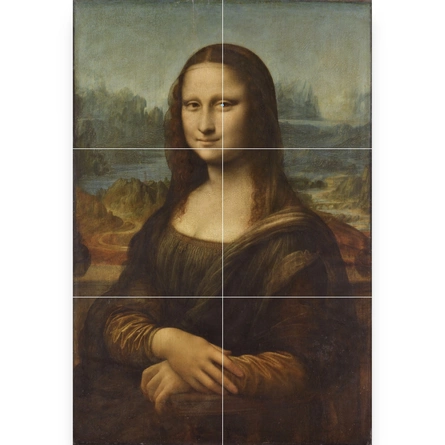
The cross
A symbolic cross is also created.
- the left edge of the 2:3 rectangle (yellow vertical) is exactly in the middle of the median vertical (red vertical) and the golden section (orange vertical)
- the line between the eyes of Ginevra (yellow horizontal) is exactly 1/5 of the height of the yellow vertical line
- the yellow horizontal intersects the yellow vertical almost exactly on 1/3 of its height
The division into 1/3 and 1/5 refers to Leonardo da Vinci's initials, L D V. These are the Roman numerals for 555, so 3 × 5.
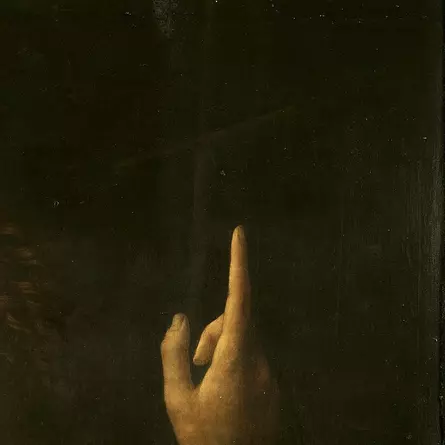
A cross can be seen only on one of the undoubtedly genuine Leonardo works, on the painting of John the Baptist
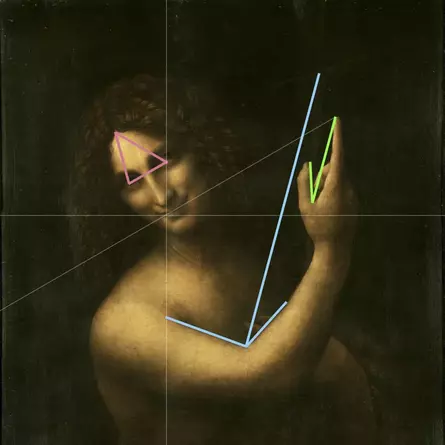
Over a geometric system of lines and angles, Leonardo has given the work his initials, L D V. White horizontals and white verticals, respectively, are the golden ratio of the image's height and width. Here, too, the golden section runs through the left eye
The hexagram
And finally a regular hexagon (hexagram) results.
- the pupil of the left eye of Ginevra now lies in the golden section of the width of the picture (orange vertical)
- the center of gravity of the yellow triangle from II is at the same time the center of a circumcircle (blue circle), which intersects the vertical golden section in two points (blue points on orange vertical)
- by connecting these points with the vertices of the already known yellow triangle a hexagram is created (blue and yellow triangle)
The hexagon is confirmed by another dependency.
- the distance from Ginevra's left eye to the upper right vertex of the hexagon is exactly twice as long as the distance from the center of the hexagon to Ginvera's right eye
At this point it becomes clear with what extraordinary playful mastery, the angles, proportions and shapes intertwine. That a painting of this painterly quality has such an elegant pictorial construction is almost unique in painting and is only surpassed by Leonardo's Last Supper. The painting of the reverse side, which is very unusual for a painting, thus does not have a merely decorative character. Rather, it serves as a simplified approach to a deeper understanding of the painting on the front.
The religious meaning of the hexagram
Two mirrored and interlocked equilateral triangles are also called the Star of David. The Star of David is the most significant symbol in Judaism. It was named after the legendary Jewish King David, who, according to legend, wore it on his shield. The symbol was supposed to protect him from harm and was considered lucky since ancient times.
The temple curl
In this context, a detail of Ginevra's hairstyle is worth mentioning. Her hair is strictly combed back. Likewise, the side curls of the left part of her head are tied back.
On the right side of her head, however, a single curl hangs down. It is also painted strikingly lighter than the rest of the hairstyle. So the painter wanted to emphasize this single curl. It is also the only part of the hairstyle that is within the triangle known from II.
The way it is depicted is reminiscent of a temple curl (Hebrew peot). Temples have a religious meaning especially in Judaism and refer to the prohibition to cut the hair (Lev 19,27).
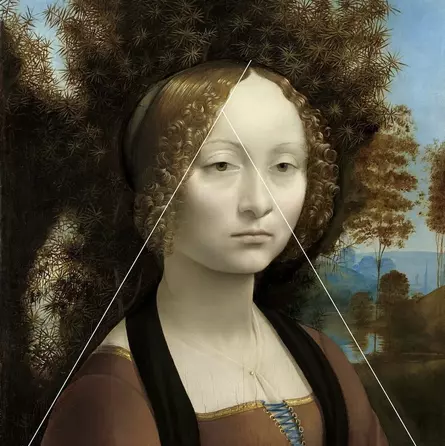
The temple curl is clearly emphasized by the equilateral triangle recognized in II
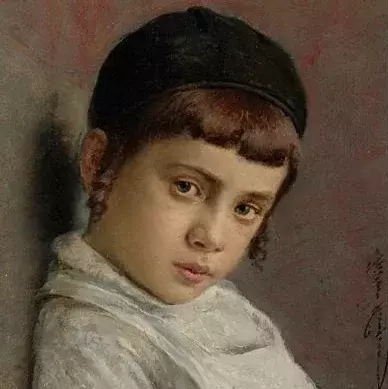
The painting was mirrored for clarity
The emphasis on the temple in Leonardo's Last Supper
An increasingly coherent picture of references to other Leonardo works emerges that can link the portrait of Ginevra de' Benci to Leonardo da Vinci. This is because the temple is also prominently featured in The Last Supper.
The perspective lines do not converge in Jesus' right eye, as is generally assumed, but the vanishing point is at his right temple. The point of impact of the nail that Leonardo used to stretch the threads can still be seen there today.
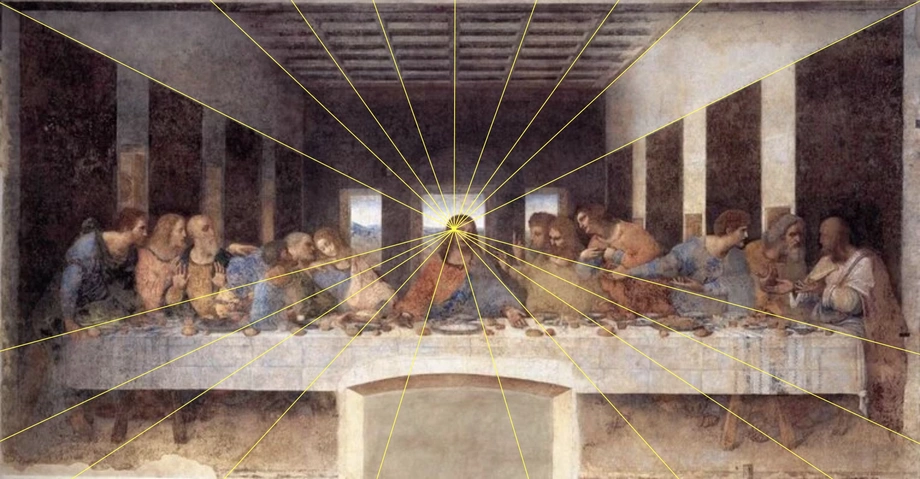
The three world religions in Europe
The painter of the portrait of Ginevra de' Benci has strictly followed the use of symbols and proportions of classical geometry.
However, the way the hexagram and the cross are staged can only be understood in a religious context. The Star of David and the Cross are the best-known symbols for Jewish and Christianity, respectively. These two great world religions have in common that they have their origin in the Bible.
However, there is a third world religion that is related to the Bible, Islam. The symbol of Islam is the crescent moon with a pentagonal star (hilal).
Due to the Ottoman conquests in Southern Europe until the 17th century - Vienna was unsuccessfully besieged in 1683 - the Islamic Ottomans had become a direct neighbor for some European nations, including the Italian ones.
Considering the Ottoman influence on the culture of Europe and the previous significance of the number 3, it would be logical to assume the Hilal as a third religious symbol in the painting, in addition to the cross and the Star of David.
IV Hilal and Geneva (ital. Ginevra)
What is the Hilal?
The hilal (Arabic for crescent moon) is the most important religious symbol in Islam. It shows the stylized crescent of the moon and can be oriented to the right or to the left. It is then either the waxing or the waning phase of the moon. The hilal is usually depicted in conjunction with one or more stars.
Although the true crescent moon can never be wider than one half of the moon, the symbol is sometimes drawn out of round. Mostly the moon circle then encloses one or more five-pointed stars.
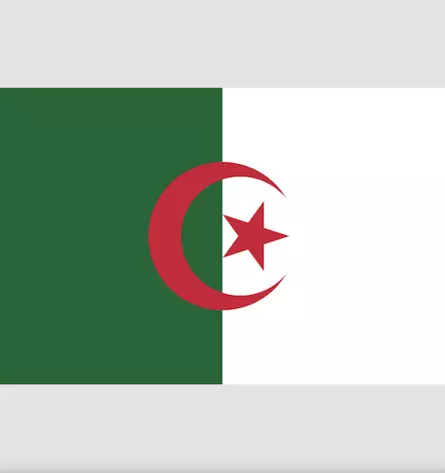
The outermost crescent of the waning moon is shown. It encloses a five-pointed star pointing to the right
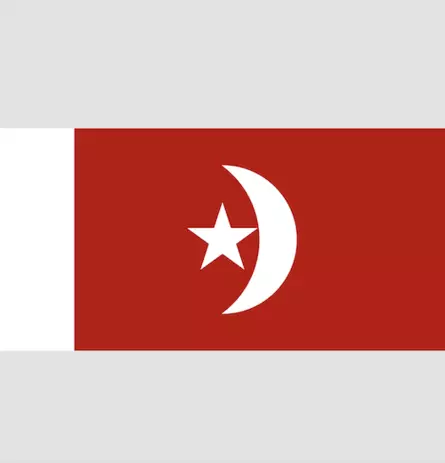
The flag of the emirate shows the crescent of the waxing moon. Next to it a five-pointed star pointing upwards.
The Construction of the Hilal in the Portrait of Ginevra de' Benci
A hilal can be constructed through the geometric relationships in the painting.
On closer inspection of the landscape, the circular shape of the hills stands out (yellow circular arcs). They are in fact circular cutouts. The Hilal with five-pointed star results from the construction of their centers.
First circle (front hill)
- from the right eye of the Ginevra a 45° angle leads to the right below
- where the distance is as long as the width of the picture, the center of the circle is located (blue point)
- the circle is exactly twice as big as the circle around Ginevra's head
Second circle (back hill)
- from Ginevra's right eye a 22.5° angle leads down to the right (22.5° is half of 45°)
- where the ray meets the horizontal through the golden button on Ginevra's cleavage is the center of the circle
- the circle is the same size as the circle around Ginevra's head
- the distance from the eye to the center of the circle is exactly half the width of the image
Five-pointed star
- the golden button on Ginevra's neckline is exactly in the center of the left radius of the second circle (white and green line on the yellow highlighted button)
- from the golden button an 18° angle points to the center of the distance from Ginevra's right eye to the center of the larger circle (white line and yellow dot)
- if a circle is drawn around the golden button which is half the size of the larger circumference (green circles), this results in the center angle of an interior pentagon: The highest point of this circle is at 90° upwards (upper green point).
- From the difference of 90° angle and the already known 18° angle (right green dot) results: 90° - 18° = 72°, the center angle of a regular pentagon (light gray star)
Hilal
- the circumcircle of the pentagon covers the larger circumcircle in the shape of a stylized crescent moon
Analogous to the geometrical construction of hexagon and cross, the construction of the crescent moon is thus also subject to a system of harmonic proportions, angles and shapes.
It is now obvious that the painter was concerned with the representation of religious symbols (mouseover). Star of David, Cross and Hilal are the symbols of the three great European religions: Judaism, Christianity and Islam.
The way the symbols are arranged gives the impression of a chronology. A smaller Star of David, a larger Christian cross and finally an Islamic Hilal in the foreground. Judaism is the oldest religion (ca. 2000 B.C.), followed by Christianity (ca. 30 A.D.), which was followed by Islam (ca. 610 A.D.).
Astronomical references
All three religions have strong references to astronomy. The position of the sun and moon plays a central role in determining their highest holidays.
- Yom Kippur (Judaism): 10th day of the first month (the lunar calendar is used in Judaism)
- Easter (Christianity): 1st Sunday after the first full moon after the spring solstice (a solar calendar is used in Christianity)
- Feast of Sacrifice (Islam): on the 10th day of the last month (in Islam a lunar calendar is used)
Essential for the determination of these dates is astronomy and therefore the knowledge of geometry (ancient Greek earth measurement).
Sun, Moon and Earth
Three circles were necessary for the construction of the religious symbols in the portrait of Ginevra de' Benci. Their arrangement and the construction lines suggest an astronomical sketch of the sun, moon and earth.
- Sun: from Ginevra's right eye, the center of the circle around her head, two rays go out to the centers of the other two circles
- Moon: was recognized in the crescent moon
- Earth: the ray from Ginevra's right eye hits the larger circle at a 45° angle (yellow dot on larger circle). This marked a place on the Earth's surface (Geneva)
- Earth: from the center of the five-pointed star in the hilal (golden button on the décolleté) an angle of 21.25° leads to the center of the larger (earth) circle. On this latitude is the city of Mecca, important in Islam
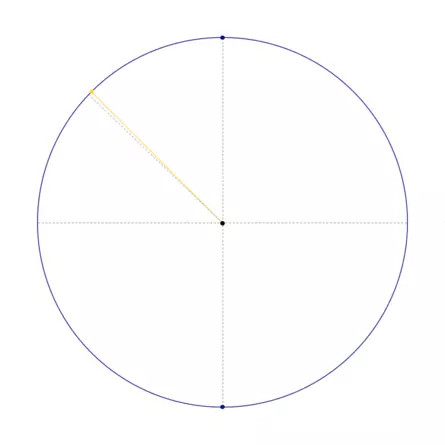
The city of Geneva (ital. Ginevra) is located approximately at 45° north latitude. The 45° angle was marked in yellow. The gray dashed line points to the actual position of Geneva (46.2° northern latitude).
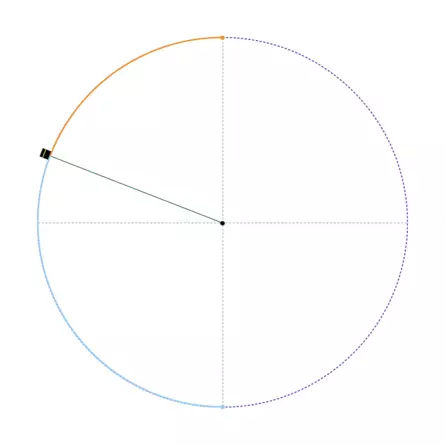
The city of Mecca (black square), important in Islam, is located exactly in the golden section (blue and orange arcs) with respect to the distance between the north and south poles.
What connects Ginevra de' Benci, Geneva and Mecca.
Ginevra is the Italian name of the Swiss city of Geneva. Ginevra's father Amerigo Benci ran the Medici Bank in Geneva at the time of Ginevra's birth. The city is very close to the 45th parallel (46.2°). The deviation is very small (0.65%), about 130km. Of all the places on the 45th parallel, Turin is the most famous. The city is located at 45.1° almost exactly on this angle.
Mecca, the birthplace of the Prophet Mohammed and today a place of pilgrimage for all Muslims, is closely associated with the golden ratio. The city is located in the golden section with respect to its position between the north and south poles (upper figure).
Mecca and Geneva are therefore in a symbolic position for geometry with regard to their position on the earth's surface. Geneva is connected with the 45° angle (diagonal of squares) and Mecca with the golden section (regular pentagons).
It is now obvious that the front large circle symbolizes the Earth, since two angles have been marked on it, pointing to important historical places. One is related to Ginevra's birth (Geneva), the other to the birth of the Prophet Muhammad.
Thus the three circles must now be interpreted as sun, moon and earth. The fact that the symbols of the three great European religions, the Star of David, the Cross and the Hilal, also result from the geometric relationships in the painting, is astonishing. Comparably complex geometric relationships can otherwise only be found in Leonardo's depiction of the Last Supper.
V The look of the hidden portrait
The painter of the portrait of Ginevra de' Benci not only added levels of content through the symbolism and geometric relationships used. He also used double images.
Double images are a classical means of painting to expand the meaning of paintings beyond what is initially recognizable, or to concretize their interpretation. Their use has been known since the early Renaissance. But medieval drawings already show this form of aesthetics.
The surrealist painter Salvador Dalí († 1989) is considered the most important artist in this field for the modern age.
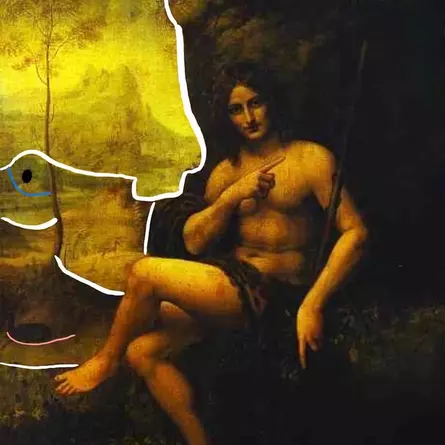
On the left of the picture, the landscape transforms into the representation of the oversized head of an elderly man
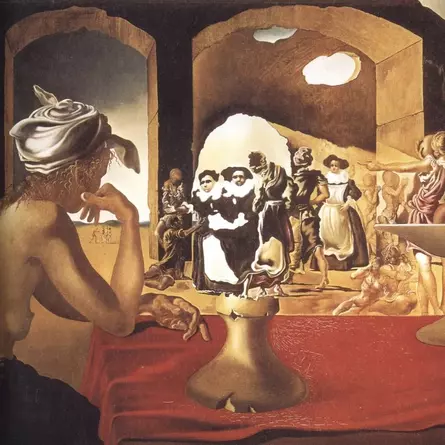
In the center the black and white bust of Voltaire can be seen, which on closer inspection turns out to be three people standing side by side
© Dalí Museum in St. Petersburg, Florida
Cross-hatching and light-dark contrasts
The juniper is not painted according to nature. The stem of a juniper branch in nature is much wider than the needles. Thus, the stroke resembles cross-hatching in the style of a drawing.
Moreover, a juniper is never as brown and black as in the painting. The execution of the juniper is thus a stylistic device, with the intention of introducing strong light-dark contrasts and fine intersecting lines.
The drawing of a face
If the eye is now focused on the bright spot in the lower left area of the juniper, the impression of a face painted frontally and looking sharply to the right is created. The person is illuminated from the front left and wears a very slanted beret that borders the right half of the face exactly at a 60° angle. The depiction is reminiscent of the self-portraits of the Dutch painter Rembrandt van Rijn († 1669).

The double image and the whole painting remind stylistically of the Dutch painting of the 17th century. Typical is a slight blurring and the lateral incidence of light into a very dark room.
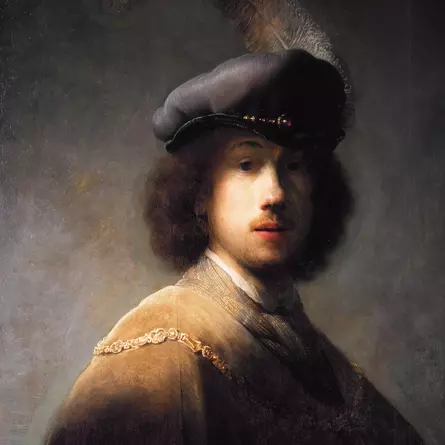
The portrait of the face in the juniper reminds of the contrasting self-portraits of Rembrandt
The church spire in view
The direction of the gaze of the portrait in the juniper is clearly recognizable and aims at the church tower of the village in the background of the landscape (red dot).
- the directive of the gaze (red line) is from the right eye of the person in the juniper exactly 7/8 of the picture width long, and has the same length as each side of the large equilateral triangle shown in II (white lines)
The trees and buildings leaning to the right in the background of the landscape are conspicuous
- the trees of the landscape are not painted vertically, but all inclined to the right by about 3.14°
- also the buildings are slightly tilted. They are also inclined by about 3.14°
So the numerical value of the angles indicates the circular shape. Because the circle number Pi (~3,14) indicates the circumference of a circle with the diameter of 1.
Behind the church tower there is a monochrome blue circular hill (dark blue line). This hill is also a section of a circle.
- the center of the circle is at the intersection of the extended line of the church tower inclined by 3.14° with the vertical line through the intersection of the circles of the two front hills (known from the construction of the crescent moon from IV) and (mouseover: gray and dark red vertical line)
- the circle is exactly 4 times as big as the circle around Ginevra's head (mouseover: dark blue circle)
The blue hill
The overdrawn monochrome representation of the last blue hill, which rises as an earthen circle in the landscape, must appear to the viewer as a painted mountain of water rising as a huge oversized and all-devouring tidal wave behind the village.
The trees and buildings leaning unnaturally to the right reinforce the stormy impression of the scene.
That in addition the serene gaze of the portrait in the juniper is aimed specifically at the church tower now gives the torrential impression in the background of the picture a political character. For the three buildings as a village as a whole are a symbol of the pyramid of estates in Europe, as shown above. They stand for the peasants (mill), the church (steeple) and the nobility (rock castle at the right edge of the picture).
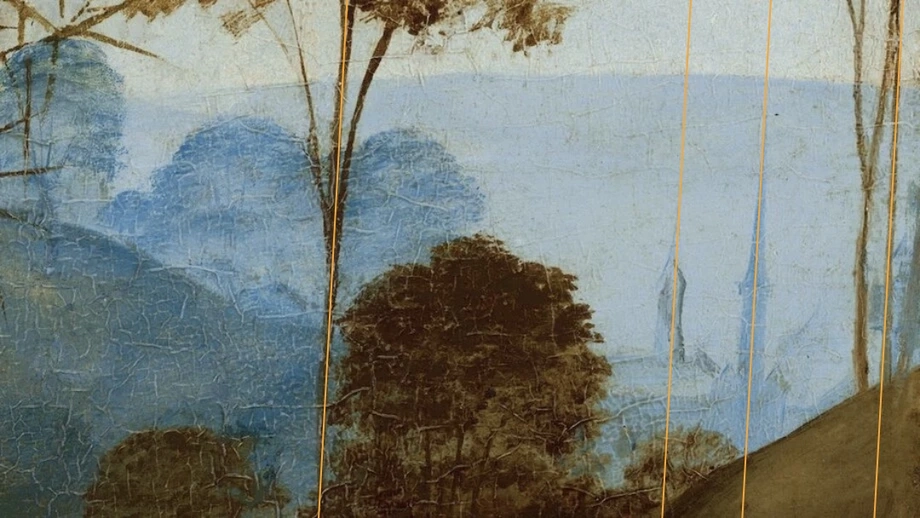
The trees in the foreground and the buildings in the background are aligned parallel and inclined at an angle of ~3.14° (orange lines)
The Age of Enlightenment
From about 1700, the Enlightenment saw the emergence of a broad philosophical movement that demanded two main things. First, the independence of science from ecclesiastical beliefs. The other was the abolition of the privileges of the nobility. It was thus an initially intellectual revolution of the third estate - educated burghers and peasants - against the domination of the other two estates, church and nobility. The three estates are symbolized by the three buildings of the landscape.
The Enlightenment reached its political climax with the U.S. Declaration of Independence (1776) and the French Revolution a few years later (1789). As a result, the citizens of the U.S. renounced the English king, while the citizens of France were granted inalienable human rights by constitution.
The rights of the Church were also severely curtailed, so much so that Napoleon, who emerged from the French Revolution, was even able to imprison the Pope in 1809.
The Enlightenment must thus be understood as a storm that swept away Europe's 1000-year-old corporative order. The tidal wave in the painting, which builds up behind the village, is emblematic of this upheaval.
Did Leonardo da Vinci paint this portrait?
In addition to the geometric suggestion of the all-seeing eye in II, which can first be traced to 1682, the question of Leonardo's authorship arises again. Did he already prophesy around 1474 the political ideas that led to the Enlightenment and closely related to it the American Revolution (1776) as well as the French Revolution (1789) and incorporated them into the painting? At that time, the elimination of the God-ordained order of estates was an unworldly utopia.
Laurel and palm leaf on the back of the painting have a political character in this form of representation and mean a political triumph. Was the work created in anticipation of this triumph over nobility and church? Then it would be a truly prophetic work of Leonardo da Vinci. Or is it more plausible that it was created immediately after the revolutionary triumph of the American and French bourgeoisie?
If so, a dating of ca. 1776-1805 would be more likely, and the thesis of Leonardo's authorship would no longer be tenable. In 1805 the painting was exhibited publicly for the first time. Before that, there are only a handful of imprecise mentions.
What speaks for an authorship of Leonardo
However, it is undeniable that the painting has features typical of Leonardo's painting, for example:
- the swirling way of depicting the curls
- the renunciation of architecture, instead only a man and nature
- the fingerprint of the painter (Leonardo is also said to have painted with his hands)
- the incorporation of biographical features into the portraits (the pale facial expression of Ginevra, abandoned by Bernardo Bembo, the similarity of the emblem on the reverse with Bernardo Bembo's seal or his motto painted over the reverse)
- the complex geometric relationships are equally leonardesque
So, if this is not a work of Leonardo da Vinci, the painter took great pains to make it look like one in purely formal terms. This would then suggest a deliberate forgery.
Likewise, very few documents exist that link the painting to Ginvera de' Benci and Bernardo Bembo (for example, Bembo's personal seal). They would have been easy to forge for a well-connected and inventive mind.
Important note:
The article is under revision from here.
More than 500 years after she was painted, Ginevra sits proudly in front of her juniper tree, half a world away from the city where she lived, in a land she didn't even know existed.
Ginevra's Story
Documentary with Meryl Streep as narrator
Unfortunately, for technical reasons, the video can no longer be played on this website, but it is still available on YouTube or can be purchased as a DVD.
The almost one-hour official documentary on the portrait of Ginevra de' Benci was produced by the National Gallery of Art, the museum where the painting is exhibited today. It is the only and most comprehensive cinematic documentary involving the museum. Actress Meryl Streep was engaged as narrator for the film. The film tells the story of the painting from the museum's point of view and goes into some of the special features of the presentation. In some scenes, the painting is shown in its original state, i.e. without framing (front: 22:48, back: 32:30).
In view of the countless experts who contributed to the museum's documentation, it is surprising why the study of the painting's geometry has been completely neglected so far.
Downloads
Sources
Website of the exhibiting museum: National Gallery of Art, Washington D.C.
Frank Zöllner, Leonardo, Taschen (2019)
Martin Kemp, Leonardo, C.H. Beck (2008)
Charles Niccholl, Leonardo da Vinci: Die Biographie, Fischer (2019)
Johannes Itten, Bildanalysen, Ravensburger (1988)
Euklid, Die Elemente, Verlag Europa Lehrmittel (2015)
Luca Pacioli, Divina Proportione, Die Lehre vom goldenen Schnitt, Forgotten Books (2018)
Especially recommended
Marianne Schneider, Das große Leonardo Buch – Sein Leben und Werk in Zeugnissen, Selbstzeugnissen und Dokumenten, Schirmer/ Mosel (2019)
Leonardo da Vinci, Schriften zur Malerei und sämtliche Gemälde, Schirmer/ Mosel (2011)
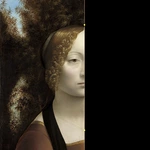
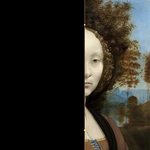
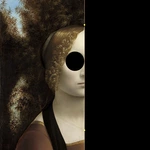
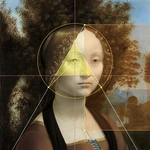
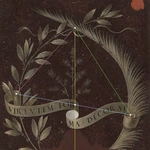
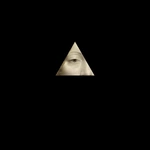
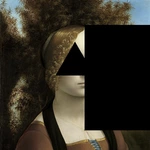
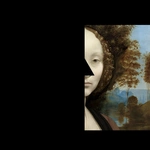
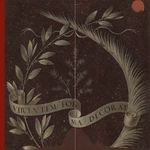
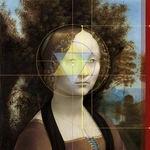
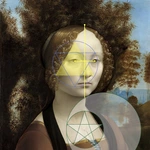
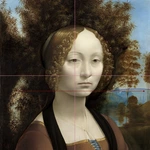
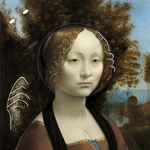
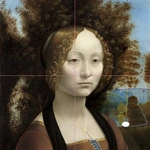
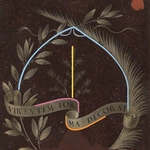
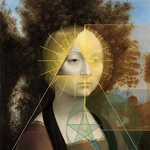
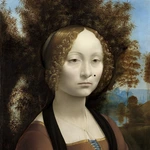
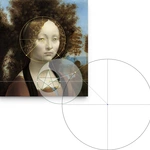
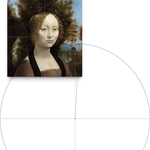
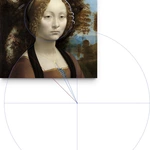
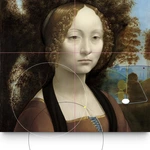
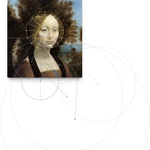
![[Translate to english:] [Translate to english:]](/fileadmin/_processed_/8/b/csm_leonardo-alle-gemaelde_2dc4b01ef6.webp.pagespeed.ce.ohfmgl8OfF.webp)
